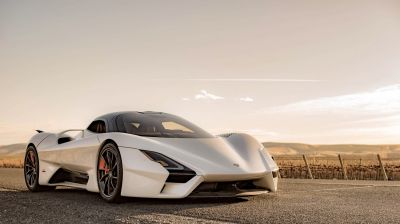 2020 Lotus Evija (Type 130) Dimensions, Size & Specs
2020 Lotus Evija (Type 130) Dimensions, Size & SpecsMeasurements of the 2020 Lotus Evija, engineered for optimal performance and comfort
| Dimensions | |
|---|---|
| Length: | 4459 mm175.6 in14.6 ft |
| Width: | 2000 mm78.7 in6.6 ft |
| Height: | 1122 mm44.2 in3.7 ft |
| Weight Specifications | |
| Curb Weight: | 1680-1894 kg3704-4176 lbs |
| Tire Specifications | |
| Rims Sizes: |
|
The Lotus Evija (Type 130), introduced in 2020 and still in production, is a groundbreaking all-electric hypercar that showcases the British automaker’s commitment to cutting-edge technology and lightweight engineering. This coupe boasts a sleek and aerodynamic body with dimensions measuring 4459 mm (175.5 inches) in length, 2000 mm (78.7 inches) in width, and only 1122 mm (44.2 inches) in height. Its low-slung profile not only enhances aesthetics but also improves aerodynamic efficiency and handling stability. Weighing in at 1680 kg (3704 lbs), the Evija maintains a remarkable power-to-weight ratio for an electric vehicle, thanks to Lotus’s extensive use of lightweight materials such as carbon fiber composites. This curb weight enables swift acceleration and agile dynamics which are hallmarks of Lotus sports cars. As one of the most advanced electric hypercars on the market, the Evija combines extreme performance with a carefully sculpted chassis. The coupe’s broad width and low height give it a commanding road presence while contributing to impressive cornering capabilities. Whether compared to traditional supercars or other electric vehicles, the Lotus Evija stands out with its unique balance of size, weight, and revolutionary electric powertrain technology. It marks a significant evolution for Lotus, blending the brand’s sports car heritage with the future of automotive propulsion.
Discover the standout features that make the 2020 Lotus Evija a leader in its class
Have a question? Please check our knowledgebase first.
The Lotus Evija (Type 130) has an overall length of 4459 mm (175.6 inches), a width of 2000 mm (78.7 inches), and a height of 1122 mm (44.2 inches). These dimensions give it a sleek and aerodynamic coupe profile typical of high-performance electric hypercars. Its width, measured without mirrors, emphasizes a wide stance for better road presence and high-speed stability, while its low height and length complement its aerodynamic shape.
The Lotus Evija weighs in at 1680 kg (3704 lbs) curb weight. Considering it is a fully electric hypercar equipped with four electric motors and a substantial battery pack, this weight is relatively light due to extensive use of carbon fiber and lightweight materials in its construction. The curb weight contributes to exceptional acceleration, agility, and handling, as keeping the weight low is crucial for maximizing the performance and efficiency of electric sports cars like the Evija.
With dimensions of 4459 mm (175.6 inches) in length, 2000 mm (78.7 inches) in width, and 1122 mm (44.2 inches) in height, the Lotus Evija can fit into a standard residential garage. Most typical single-car garages have widths around 2400 to 3000 mm (94.5 to 118 inches) and lengths of about 4800 to 6100 mm (189 to 240 inches). The Evija’s width is wide but still provides enough clearance for door openings and maneuvering inside a standard garage, though careful parking is recommended due to its wide stance.
The Lotus Evija (Type 130) is a significant departure in terms of size compared to traditional Lotus models, which are generally smaller and lighter sports cars. While Lotus has not produced a direct predecessor hypercar with similar electric technology, the Evija is larger and heavier than famous Lotus roadsters like the Elise or Exige. Its increased dimensions and weight accommodate advanced electric components such as a large battery and multiple electric motors, showcasing Lotus's evolution toward high-performance electric hypercar technology while maintaining the brand's commitment to lightness and agility.
The Lotus Evija features a two-seat coupe layout typical of hypercars, meaning interior space is focused on driver and passenger comfort and performance ergonomics rather than cargo or rear passenger room. Though exact interior dimension figures are not typically disclosed for hypercars, the relatively low height of 1122 mm (44.2 inches) and wide cabin suggest a snug, driver-focused cockpit designed to promote an immersive driving experience. Storage capacity is minimal, focusing primarily on housing electrical systems and providing adequate space for driver controls.
The Lotus Evija competes with other electric hypercars like the Rimac Nevera and Pininfarina Battista. In terms of size, the Evija’s length of 4459 mm (175.6 inches) is generally on par or slightly shorter than these rivals, while its width of 2000 mm (78.7 inches) is comparable, providing a wide and low-slung presence. These dimensions contribute to its aerodynamics and performance similarly to its competitors, striking a balance between aggressive design and practical vehicle footprint for a hypercar.
Lotus has not publicly specified the exact ground clearance measurement for the Evija; however, given its hypercar design with a focus on aerodynamics and performance, it features a low ride height typical of such vehicles. The likely ground clearance is very limited, generally under 100 mm (4 inches), which enhances downforce and handling at the cost of reduced practicality on rough roads or steep driveways. Owners should exercise caution when navigating speed bumps, curbs, or uneven terrain.
While the exact wheelbase and track width figures for the Lotus Evija Type 130 have not been released broadly, its design indicates a long wheelbase and wide track to ensure stability, precise steering, and optimal weight distribution. The wide 2000 mm (78.7 inches) overall width suggests large track widths front and rear, which contribute to excellent cornering grip and stability at high speeds. The suspension and chassis are engineered around these dimensions to provide sharp yet stable handling in line with Lotus’s reputation.
As a two-seat electric hypercar, the Lotus Evija’s coupe body style prioritizes performance and style over cargo capacity or practicality. Expect very limited cargo space suitable for small items or driving essentials. This is typical in the hypercar segment where low rooflines and wide stances enhance aerodynamics but restrict everyday usability features such as extensive storage or rear seating. While thrilling for performance driving, the Evija is less suited for daily utility purposes.
The Lotus Evija’s design integrates a carbon fiber monocoque chassis which is both lightweight and extremely strong, helping to protect occupants during collisions. Its wide track and low center of gravity, as defined by its 4459 mm length and 2000 mm width, improve vehicle stability to avoid accidents. Additionally, the coupe body’s structure and engineered crumple zones absorb impact energy effectively. Together, these design aspects leverage the vehicle’s dimensions and architecture to maximize passive safety alongside advanced electronic safety systems.
Discover similar sized cars.

| Production: | 2019-present |
|---|---|
| Model Year: | 2019 |
| Length: | 4430 mm174.4 in |
| Width: | 1991 mm78.4 in |
| Height: | 1092 mm43.0 in |
